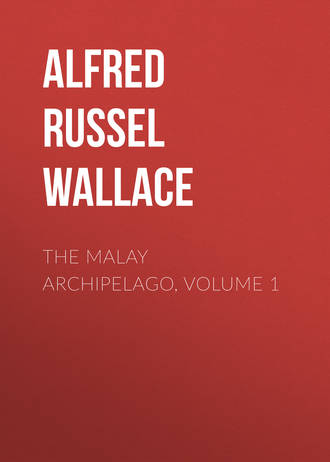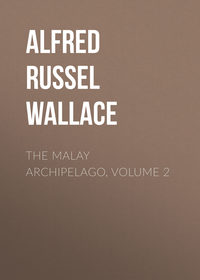 полная версия
полная версияThe Malay Archipelago, Volume 1
About noon we reached the village of Menyerry, beautifully situated on a spur of the mountain about 600 feet above the valley, and affording a delightful view of the mountains of this part of Borneo. I here got a sight of Penrissen Mountain, at the head of the Sarawak River, and one of the highest in the district, rising to about 6,000 feet above the sea. To the south the Rowan, and further off the Untowan Mountains in the Dutch territory appeared equally lofty. Descending from Menyerry we again crossed the Kayan, which bends round the spur, and ascended to the pass which divides the Sadong and Sarawak valleys, and which is about 2,000 feet high. The descent from this point was very fine. A stream, deep in a rocky gorge, rushed on each side of us, to one of which we gradually descended, passing over many lateral gullys and along the faces of some precipices by means of native bamboo bridges. Some of these were several hundred feet long and fifty or sixty high, a single smooth bamboo four inches diameter forming the only pathway, while a slender handrail of the same material was often so shaky that it could only be used as a guide rather than a support.
Late in the afternoon we reached Sodos, situated on a spur between two streams, but so surrounded by fruit trees that little could be seen of the country. The house was spacious, clean and comfortable, and the people very obliging. Many of the women and children had never seen a white man before, and were very sceptical as to my being the same colour all over, as my face. They begged me to show them my arms and body, and they were so kind and good-tempered that I felt bound to give them some satisfaction, so I turned up my trousers and let them see the colour of my leg, which they examined with great interest.
In the morning early we continued our descent along a fine valley, with mountains rising 2,000 or 3,000 feet in every direction. The little river rapidly increased in size until we reached Senna, when it had become a fine pebbly stream navigable for small canoes. Here again the upheaved slatey rock appeared, with the same dip and direction as in the Sadong River. On inquiring for a boat to take me down the stream, I was told that the Senna Dyaks, although living on the river-banks, never made or used boats. They were mountaineers who had only come down into the valley about twenty years before, and had not yet got into new habits. They are of the same tribe as the people of Menyerry and Sodos. They make good paths and bridges, and cultivate much mountain land, and thus give a more pleasing and civilized aspect to the country than where the people move about only in boats, and confine their cultivation to the banks of the streams.
After some trouble I hired a boat from a Malay trader, and found three Dyaks who had been several times with Malays to Sarawak, and thought they could manage it very well. They turned out very awkward, constantly running aground, striking against rocks, and losing their balance so as almost to upset themselves and the boat—offering a striking contrast to the skill of the Sea Dyaks. At length we came to a really dangerous rapid where boats were often swamped, and my men were afraid to pass it. Some Malays with a boatload of rice here overtook us, and after safely passing down kindly sent back one of their men to assist me. As it was, my Dyaks lost their balance in the critical part of the passage, and had they been alone would certainly have upset the boat. The river now became exceedingly picturesque, the ground on each side being partially cleared for ricefields, affording a good view of the country. Numerous little granaries were built high up in trees overhanging the river, and having a bamboo bridge sloping up to them from the bank; and here and there bamboo suspension bridge crossed the stream, where overhanging trees favoured their construction.
I slept that night in the village of the Sebungow Dyaks, and the next day reached Sarawak, passing through a most beautiful country where limestone mountains with their fantastic forms and white precipices shot up on every side, draped and festooned with a luxuriant vegetation. The banks of the Sarawak River are everywhere covered with fruit trees, which supply the Dyaks with a great deal of their food. The Mangosteen, Lansat, Rambutan, Jack, Jambou, and Blimbing, are all abundant; but most abundant and most esteemed is the Durian, a fruit about which very little is known in England, but which both by natives and Europeans in the Malay Archipelago is reckoned superior to all others. The old traveller Linschott, writing in 1599, says: "It is of such an excellent taste that it surpasses in flavour all the other fruits of the world, according to those who have tasted it." And Doctor Paludanus adds: "This fruit is of a hot and humid nature. To those not used to it, it seems at first to smell like rotten onions, but immediately when they have tasted it, they prefer it to all other food. The natives give it honourable titles, exalt it, and make verses on it." When brought into a house the smell is often so offensive that some persons can never bear to taste it. This was my own case when I first tried it in Malacca, but in Borneo I found a ripe fruit on the ground, and, eating it out of doors, I at once became a confirmed Durian eater.
The Durian grows on a large and lofty forest tree, somewhat resembling an elm in its general character, but with a more smooth and scaly bark. The fruit is round or slightly oval, about the size of a large cocoanut, of a green colour, and covered all over with short stout spines the bases of which touch each other, and are consequently somewhat hexagonal, while the points are very strong and sharp. It is so completely armed, that if the stalk is broken off it is a difficult matter to lift one from the ground. The outer rind is so thick and tough, that from whatever height it may fall it is never broken. From the base to the apex five very faint lines may be traced, over which the spines arch a little; these are the sutures of the carpels, and show where the fruit may be divided with a heavy knife and a strong hand. The five cells are satiny white within, and are each filled with an oval mass of cream-coloured pulp, imbedded in which are two or three seeds about the size of chestnuts. This pulp is the eatable part, and its consistency and flavour are indescribable. A rich butter-like custard highly flavoured with almonds gives the best general idea of it, but intermingled with it come wafts of flavour that call to mind cream-cheese, onion-sauce, brown sherry, and other incongruities. Then there is a rich glutinous smoothness in the pulp which nothing else possesses, but which adds to its delicacy. It is neither acid, nor sweet, nor juicy; yet one feels the want of none of these qualities, for it is perfect as it is. It produces no nausea or other bad effect, and the more you eat of it the less you feel inclined to stop. In fact to eat Durians is a new sensation, worth a voyage to the East to experience.
When the fruit is ripe it falls of itself, and the only way to eat Durians in perfection is to get them as they fall; and the smell is then less overpowering. When unripe, it makes a very good vegetable if cooked, and it is also eaten by the Dyaks raw. In a good fruit season large quantities are preserved salted, in jars and bamboos, and kept the year round, when it acquires a most disgusting odour to Europeans, but the Dyaks appreciate it highly as a relish with their rice. There are in the forest two varieties of wild Durians with much smaller fruits, one of them orange-coloured inside; and these are probably the origin of the large and fine Durians, which are never found wild. It would not, perhaps, be correct to say that the Durian is the best of all fruits, because it cannot supply the place of the subacid juicy kinds, such as the orange, grape, mango, and mangosteen, whose refreshing and cooling qualities are so wholesome and grateful; but as producing a food of the most exquisite flavour, it is unsurpassed. If I had to fix on two only, as representing the perfection of the two classes, I should certainly choose the Durian and the Orange as the king and queen of fruits.
The Durian is, however, sometimes dangerous. When the fruit begins to ripen it falls daily and almost hourly, and accidents not unfrequently happen to persons walking or working under the trees. When a Durian strikes a man in its fall, it produces a dreadful wound, the strong spines tearing open the flesh, while the blow itself is very heavy; but from this very circumstance death rarely ensues, the copious effusion of blood preventing the inflammation which might otherwise take place. A Dyak chief informed me that he had been struck down by a Durian falling on his head, which he thought would certainly have caused his death, yet he recovered in a very short time.
Poets and moralists, judging from our English trees and fruits, have thought that small fruits always grew on lofty trees, so that their fall should be harmless to man, while the large ones trailed on the ground. Two of the largest and heaviest fruits known, however, the Brazil-nut fruit (Bertholletia) and Durian, grow on lofty forest trees, from which they fall as soon as they are ripe, and often wound or kill the native inhabitants. From this we may learn two things: first, not to draw general conclusions from a very partial view of nature; and secondly, that trees and fruits, no less than the varied productions of the animal kingdom, do not appear to be organized with exclusive reference to the use and convenience of man.
During my many journeys in Borneo, and especially during my various residences among the Dyaks, I first came to appreciate the admirable qualities of the Bamboo. In those parts of South America which I had previously visited, these gigantic grasses were comparatively scarce; and where found but little used, their place being taken as to one class of uses by the great variety of Palms, and as to another by calabashes and gourds. Almost all tropical countries produce Bamboos, and wherever they are found in abundance the natives apply them to a variety of uses. Their strength, lightness, smoothness, straightness, roundness and hollowness, the facility and regularity with which they can be split, their many different sizes, the varying length of their joints, the ease with which they can be cut and with which holes can be made through them, their hardness outside, their freedom from any pronounced taste or smell, their great abundance, and the rapidity of their growth and increase, are all qualities which render them useful for a hundred different purposes, to serve which other materials would require much more labour and preparation. The Bamboo is one of the most wonderful and most beautiful productions of the tropics, and one of nature's most valuable gifts to uncivilized man.
The Dyak houses are all raised on posts, and are often two or three hundred feet long and forty or fifty wide. The floor is always formed of strips split from large Bamboos, so that each may be nearly flat and about three inches wide, and these are firmly tied down with rattan to the joists beneath. When well made, this is a delightful floor to walk upon barefooted, the rounded surfaces of the bamboo being very smooth and agreeable to the feet, while at the same time affording a firm hold. But, what is more important, they form with a mat over them an excellent bed, the elasticity of the Bamboo and its rounded surface being far superior to a more rigid and a flatter floor. Here we at once find a use for Bamboo which cannot be supplied so well by another material without a vast amount of labour—palms and other substitutes requiring much cutting and smoothing, and not being equally good when finished. When, however, a flat, close floor is required, excellent boards are made by splitting open large Bamboos on one side only, and flattening them out so as to form slabs eighteen inches wide and six feet long, with which some Dyaks floor their houses. These with constant rubbing of the feet and the smoke of years become dark and polished, like walnut or old oak, so that their real material can hardly be recognised. What labour is here saved to a savage whose only tools are an axe and a knife, and who, if he wants boards, must hew them out of the solid trunk of a tree, and must give days and weeks of labour to obtain a surface as smooth and beautiful as the Bamboo thus treated affords him. Again, if a temporary house is wanted, either by the native in his plantation or by the traveller in the forest, nothing is so convenient as the Bamboo, with which a house can be constructed with a quarter of the labour and time than if other materials are used.
As I have already mentioned, the Hill Dyaks in the interior of Sarawak make paths for long distances from village to village and to their cultivated grounds, in the course of which they have to cross many gullies and ravines, and even rivers; or sometimes, to avoid a long circuit, to carry the path along the face of a precipice. In all these cases the bridges they construct are of Bamboo, and so admirably adapted is the material for this purpose, that it seems doubtful whether they ever would have attempted such works if they had not possessed it. The Dyak bridge is simple but well designed. It consists merely of stout Bamboos crossing each other at the road-way like the letter X, and rising a few feet above it. At the crossing they are firmly bound together, and to a large Bamboo which lays upon them and forms the only pathway, with a slender and often very shaky one to serve as a handrail. When a river is to be crossed, an overhanging tree is chosen from which the bridge is partly suspended and partly supported by diagonal struts from the banks, so as to avoid placing posts in the stream itself, which would be liable to be carried away by floods. In carrying a path along the face of a precipice, trees and roots are made use of for suspension; struts arise from suitable notches or crevices in the rocks, and if these are not sufficient, immense Bamboos fifty or sixty feet long are fixed on the banks or on the branch of a tree below. These bridges are traversed daily by men and women carrying heavy loads, so that any insecurity is soon discovered, and, as the materials are close at hand, immediately repaired. When a path goes over very steep ground, and becomes slippery in very wet or very dry weather, the Bamboo is used in another way. Pieces are cut about a yard long, and opposite notches being made at each end, holes are formed through which pegs are driven, and firm and convenient steps are thus formed with the greatest ease and celerity. It is true that much of this will decay in one or two seasons, but it can be so quickly replaced as to make it more economical than using a harder and more durable wood.
One of the most striking uses to which Bamboo is applied by the Dyaks, is to assist them in climbing lofty trees by driving in pegs in the way I have already described at page 85. This method is constantly used in order to obtain wax, which is one of the most valuable products of the country. The honey-bee of Borneo very generally hangs its combs under the branches of the Tappan, a tree which towers above all others in the forest, and whose smooth cylindrical trunk often rises a hundred feet without a branch. The Dyaks climb these lofty trees at night, building up their Bamboo ladder as they go, and bringing down gigantic honeycombs. These furnish them with a delicious feast of honey and young bees, besides the wax, which they sell to traders, and with the proceeds buy the much-coveted brass wire, earrings, and bold-edged handkerchiefs with which they love to decorate themselves. In ascending Durian and other fruit trees which branch at from thirty to fifty feet from the ground, I have seen them use the Bamboo pegs only, without the upright Bamboo which renders them so much more secure.
The outer rind of the Bamboo, split and shaved thin, is the strongest material for baskets; hen-coops, bird-cages, and conical fish-traps are very quickly made from a single joint, by splitting off the skin in narrow strips left attached to one end, while rings of the same material or of rattan are twisted in at regular distances. Water is brought to the houses by little aqueducts formed of large Bamboos split in half and supported on crossed sticks of various heights so as to give it a regular fall. Thin long-jointed Bamboos form the Dyaks' only water-vessels, and a dozen of them stand in the corner of every house. They are clean, light, and easily carried, and are in many ways superior to earthen vessels for the same purpose. They also make excellent cooking utensils; vegetables and rice can be boiled in them to perfection, and they are often used when travelling. Salted fruit or fish, sugar, vinegar, and honey are preserved in them instead of in jars or bottles. In a small Bamboo case, prettily carved and ornamented, the Dyak carries his sirih and lime for betel chewing, and his little long-bladed knife has a Bamboo sheath. His favourite pipe is a huge hubble-bubble, which he will construct in a few minutes by inserting a small piece of Bamboo for a bowl obliquely into a large cylinder about six inches from the bottom containing water, through which the smoke passes to a long slender Bamboo tube. There are many other small matters for which Bamboo is daily used, but enough has now been mentioned to show its value. In other parts of the Archipelago I have myself seen it applied to many new uses, and it is probable that my limited means of observation did not make me acquainted with one-half the ways in which it is serviceable to the Dyaks of Sarawak.
While upon the subject of plants I may here mention a few of the more striking vegetable productions of Borneo. The wonderful Pitcher-plants, forming the genus Nepenthes of botanists, here reach their greatest development. Every mountain-top abounds with them, running along the ground, or climbing over shrubs and stunted trees; their elegant pitchers hanging in every direction. Some of these are long and slender, resembling in form the beautiful Philippine lace-sponge (Euplectella), which has now become so common; others are broad and short. Their colours are green, variously tinted and mottled with red or purple. The finest yet known were obtained on the summit of Kini-balou, in North-west Borneo. One of the broad sort, Nepenthes rajah, will hold two quarts of water in its pitcher. Another, Nepenthes Edwardsiania, has a narrow pitcher twenty inches long; while the plant itself grows to a length of twenty feet.
Ferns are abundant, but are not so varied as on the volcanic mountains of Java; and Tree-ferns are neither so plentiful nor so large as on that island. They grow, however, quite down to the level of the sea, and are generally slender and graceful plants from eight to fifteen feet high. Without devoting much time to the search I collected fifty species of Ferns in Borneo, and I have no doubt a good botanist would have obtained twice the number. The interesting group of Orchids is very abundant, but, as is generally the case, nine-tenths of the species have small and inconspicuous flowers. Among the exceptions are the fine Coelogynes, whose large clusters of yellow flowers ornament the gloomiest forests, and that most extraordinary plant, Vanda Lowii, which last is particularly abundant near some hot springs at the foot of the Penin-jauh Mountain. It grows on the lower branches of trees, and its strange pendant flower-spires often hang down so as almost to reach the ground. These are generally six or eight feet long, bearing large and handsome flowers three inches across, and varying in colour from orange to red, with deep purple-red spots. I measured one spike, which reached the extraordinary length of nine feet eight inches, and bore thirty-six flowers, spirally arranged upon a slender thread-like stalk. Specimens grown in our English hot-houses have produced flower-spires of equal length, and with a much larger number of blossoms.
Flowers were scarce, as is usual in equatorial forests, and it was only at rare intervals that I met with anything striking. A few fine climbers were sometimes seen, especially a handsome crimson and yellow Aeschynanthus, and a fine leguminous plant with clusters of large Cassia-like flowers of a rich purple colour. Once I found a number of small Anonaceous trees of the genus Polyalthea, producing a most striking effect in the gloomy forest shades. They were about thirty feet high, and their slender trunks were covered with large star-like crimson flowers, which clustered over them like garlands, and resembled some artificial decoration more than a natural product.
The forests abound with gigantic trees with cylindrical, buttressed, or furrowed stems, while occasionally the traveller comes upon a wonderful fig-tree, whose trunk is itself a forest of stems and aerial roots. Still more rarely are found trees which appear to have begun growing in mid-air, and from the same point send out wide-spreading branches above and a complicated pyramid of roots descending for seventy or eighty feet to the ground below, and so spreading on every side, that one can stand in the very centre with the trunk of the tree immediately overhead. Trees of this character are found all over the Archipelago, and the accompanying illustration (taken from one which I often visited in the Aru Islands) will convey some idea of their general character. I believe that they originate as parasites, from seeds carried by birds and dropped in the fork of some lofty tree. Hence descend aerial roots, clasping and ultimately destroying the supporting tree, which is in time entirely replaced by the humble plant which was at first dependent upon it. Thus we have an actual struggle for life in the vegetable kingdom, not less fatal to the vanquished than the struggles among animals which we can so much more easily observe and understand. The advantage of quicker access to light and warmth and air, which is gained in one way by climbing plants, is here obtained by a forest tree, which has the means of starting in life at an elevation which others can only attain after many years of growth, and then only when the fall of some other tree has made room for then. Thus it is that in the warm and moist and equable climate of the tropics, each available station is seized upon and becomes the means of developing new forms of life especially adapted to occupy it.
On reaching Sarawak early in December, I found there would not be an opportunity of returning to Singapore until the latter end of January. I therefore accepted Sir James Brooke's invitation to spend a week with him and Mr. St. John at his cottage on Peninjauh. This is a very steep pyramidal mountain of crystalline basaltic rock, about a thousand feet high, and covered with luxuriant forest. There are three Dyak villages upon it, and on a little platform near the summit is the rude wooden lodge where the English Rajah was accustomed to go for relaxation and cool fresh air. It is only twenty miles up the river, but the road up the mountain is a succession of ladders on the face of precipices, bamboo bridges over gullies and chasms, and slippery paths over rocks and tree-trunks and huge boulders as big as houses. A cool spring under an overhanging rock just below the cottage furnished us with refreshing baths and delicious drinking water, and the Dyaks brought us daily heaped-up baskets of Mangosteens and Lansats, two of the most delicious of the subacid tropical fruits. We returned to Sarawak for Christmas (the second I had spent with Sir James Brooke), when all the Europeans both in the town and from the out-stations enjoyed the hospitality of the Rajah, who possessed in a pre-eminent degree the art of making every one around him comfortable and happy.
A few days afterwards I returned to the mountain with Charles and a Malay boy named Ali and stayed there three weeks for the purpose of making a collection of land-shells, butterflies and moths, ferns and orchids. On the hill itself ferns were tolerably plentiful, and I made a collection of about forty species. But what occupied me most was the great abundance of moths which on certain occasions I was able to capture. As during the whole of my eight years' wanderings in the East I never found another spot where these insects were at all plentiful, it will be interesting to state the exact conditions under which I here obtained them.
On one side of the cottage there was a verandah, looking down the whole side of the mountain and to its summit on the right, all densely clothed with forest. The boarded sides of the cottage were whitewashed, and the roof of the verandah was low, and also boarded and whitewashed. As soon as it got dark I placed my lamp on a table against the wall, and with pins, insect-forceps, net, and collecting-boxes by my side, sat down with a book. Sometimes during the whole evening only one solitary moth would visit me, while on other nights they would pour in, in a continual stream, keeping me hard at work catching and pinning till past midnight. They came literally by the thousands. These good nights were very few. During the four weeks that I spent altogether on the hill I only had four really good nights, and these were always rainy, and the best of them soaking wet. But wet nights were not always good, for a rainy moonlight night produced next to nothing. All the chief tribes of moths were represented, and the beauty and variety of the species was very great. On good nights I was able to capture from a hundred to two hundred and fifty moths, and these comprised on each occasion from half to two-thirds that number of distinct species. Some of them would settle on the wall, some on the table, while many would fly up to the roof and give me a chase all over the verandah before I could secure them. In order to show the curious connection between the state of weather and the degree in which moths were attracted to light, I add a list of my captures each night of my stay on the hill:









